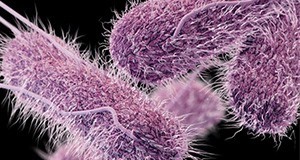Abstract
Typhoid fever is a blood infection caused by the consumption of food or water contaminated with the bacterium Salmonella enterica. Typhoid fever is easily controlled and relatively uncommon in the United States, but an estimated 21.5 million people per year are affected by typhoid fever in developing nations including regions in Asia, Africa, and South America. Many of the cases of typhoid fever in the United States are acquired through international travel to these regions. This revised 4-page fact sheet explains the causes and symptoms of typhoid fever, as well as describing who is at risk, what foods have commonly been associated with typhoid fever, and how to implement certain sanitation methods to prevent the spread of typhoid fever. Written by Keith R. Schneider, Renée Goodrich Schneider, and Rachael Silverberg, and published by the Food Science and Human Nutrition Department, January 2016.
FSHN0514/FS125: Preventing Foodborne Illness: Typhoid Fever—Salmonella Typhi (ufl.edu)
References
Centers for Disease Control and Prevention (CDC). 2012. "Typhoid Vaccines: What You Need to Know." Accessed January 5, 2016. http://www.cdc.gov/vaccines/hcp/vis/vis-statements/typhoid.html
Chatterjee, A., M. Varman, and C. O'Keefe. 2014. "Pediatric Salmonella Infection Clinical Presentation." Medscape. Accessed Jan 5, 2016. http://emedicine.medscape.com/article/968672-clinical
Food and Drug Administration (FDA). 2013. "Food Code 2013. U.S. Public Health Service." Accessed January 5, 2016. http://www.fda.gov/downloads/Food/GuidanceRegulation/RetailFoodProtection/FoodCode/UC374510.pdf
Food and Drug Administration (FDA). 2015. "Real Progress in Food Code Adoption." Accessed Jan 5, 2016. http://www.fda.gov/downloads/Food/GuidanceRegulation/RetailFoodProtection/FoodCode/UC476819.pdf
Gilman, R., M. Terminel, M. Levine, P. Hernandez-Mendoza, and R. Hornick. 1975. "Relative efficacy of blood, urine, rectal swab, bone-marrow, and rose-spot cultures for recovery of Salmonella typhi in typhoid fever." Lancet. 1(7918): 1211-3. https://doi.org/10.1016/S0140-6736(75)92194-7
Gonzalez-Escobedo, G., J. Marshall, and J. Gunn. 2011. "Chronic and acute infection of the gall bladder by Salmonella Typhi: understanding the carrier state." Nature Reviews Microbiology. 9:9-14. https://doi.org/10.1038/nrmicro2490
Gopinath, S., S. Carden, and D. Monack. 2012. "Shedding light on Salmonella carriers." Trends in Microbiology. 20(7):320-327. Accessed January 5, 2016. http://www.sciencedirect.com/science/article/pii/S0966842X12000777l https://doi.org/10.1016/j.tim.2012.04.004
Memon, A.A. 2001. "Perforated gallbladder: A Case Report." Journal of Surgery Pakistan. 6:37-38.
Rosenberg, J. 2015. "Typhoid Mary: The Sad Story of a Women Responsible for Several Typhoid Outbreaks." Accessed January 5, 2016. http://history1900s.about.com/od/1900s/a/typhoidmary.htm
Song, J., H. Cho, M. Park, D. Na, H. Moon, and C. Pai. 1993. "Detection of Salmonella typhi in the Blood of Patients with Typhoid Fever by Polymerase Chain Reaction." Journal of Clinical Microbiology. 31(6):1439-1443. https://doi.org/10.1128/JCM.31.6.1439-1443.1993
Sukanya, S., S. Rachana, V. Lakshmi, S. Rashesh, N. Bheerappa, and S. Uppin. 2013. "Biliary peritonitis due to typhoid perforation of the gall bladder - a case report." Archives of Clinical Microbiology. 4(1):1-3.
World Health Organization (WHO). 2008. "Weekly epidemiological record." 6(83):49-60. Accessed January 5, 2016. http://www.who.int/wer/2008/wer8306.pdf?ua=1
World Health Organization (WHO). 2001. "Water-related Diseases: Typhoid and paratyphoid enteric fevers." Accessed January 5, 2016. http://www.who.int/water_sanitation_health/diseases/typhoid/en/

